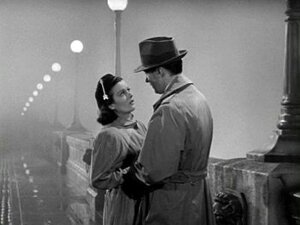
To be honest, I’ve never been a big Robert Altman fan, though increasingly I’m finding his movies more appealing. I think his approach creates the sense in me that I’m listening to a slow-talker and I want to interrupt and say, “Move it along; get to the point.” There’s an improvisational feel to character interaction and part of me want’s it more closely scripted and edited.
In The Long Goodbye this comes across partly because Altman gives his actors more responsibility to actually act, as he does with Elliott Gould here, and partly because the camera is constantly moving, as if you as a viewer are watching and trying to find a better vantage point. Some shots are through windows; some are even reflections in windows.
It’s intriguing, yet for me a bit irksome — but that’s just a personal, subjective thing. And what is odd about it is that I like this movie nonetheless.
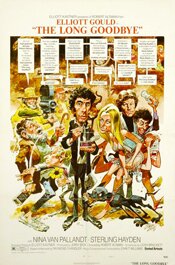 The Long Goodbye (1973)
The Long Goodbye (1973)
Directed by Robert Altman
Robert Altman’s The Long Goodbye is a bit like a fast food hamburger. It has beef in it but also has so many other things, and it has been altered to such a degree, that while it resembles a hamburger, it ain’t no hamburger.
In the same way, Altman’s movie is Raymond Chandler’s book, and resembles a film version of that book, but it ain’t Chandler’s book.
But then, you wouldn’t expect Altman to make a movie utterly faithful to its source.
Altman’s movie begins with the question, “What would happen if Marlowe, a character of the 40s and 50s, were to wake up and find himself in the early 70s?” In an interview, he says they referred to it as “Rip Van Marlowe” during the making of the movie. This idea dictates how the movie plays out.
Chandler’s Marlowe began in 1939 with The Big Sleep. His book The Long Goodbye was published in 1953. That is exactly twenty years before Altman’s The Long Goodbye.
Chandler’s Marlowe had been in about six books prior to the 1953 book. In The Long Goodbye, his Marlowe is older and mellower. The novel is a bit more reflective and, in my opinion, weighty. There is less emphasis on the tough guy posturing of the early books; he comes across as a more mature character. In some ways, there is a sense of alternating melancholy and apathy in him.
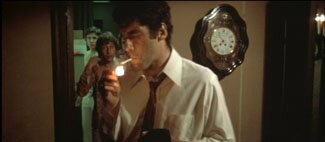
This may be what suggests the “Rip Van Marlowe” possibility to screenwriter Leigh Brackett and director Altman, or at least what makes this book a possible vehicle for working out that theme. However, there is more to the theme than just the “what if” aspect of a man from 1953 waking up in 1973. One thing that has changed for Marlowe is how people view friendship. The world has a different sense of ethics and morality and it isn’t in sync with his.
The movie opens with Philip Marlowe (Elliott Gould) literally waking up. The first half of the movie, particularly the first twenty minutes or so, give us such a slovenly, disconnected and half-asleep Marlowe that, the portrayal being so effective, he is incredibly annoying. He speaks under his breath, muttering to himself more than anyone else, even when responding to others around him. He’s almost completely unengaged with his world.
He shows no animation at all until his friend, Terry Lennox (Jim Bouton) shows up at his door. This is where the story’s engine turns over and it gets underway as Terry asks Marlowe to take him to Mexico.
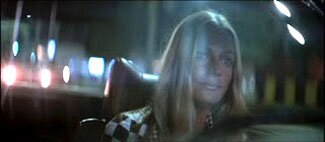
The story makes some major turns from the Chandler book, some for the purposes of condensation and some … Perhaps because they didn’t want to make a movie faithful to its source but one that stood on its own legs as unique.
Having re-read the book recently (which is probably why I keep referring back to it), and it being my favourite of the Chandler novels, I can’t say I like the deviations. I found the book had more meaning for me than the movie largely because of those things that have been changed, though I do like the movie on its own merits.
But the book’s ending is much more effective and moving, I think. The movie is very direct – you can’t miss its point. In a way, it’s like Altman believes he has to be direct because people in 1973 are as much asleep as Marlowe was. His conclusion is like a bucket of cold water in the face.
The “asleep” idea recurs through the movie. It’s not just Marlowe who is somnambulant. His neighbours, the young women with their yoga and exercise, appear to be lost in their own world of new age exercise and spirituality. Roger Wade (Sterling Haydon) is lost in his alcohol and self-pity. Everyone is self-absorbed and inward looking and Marlowe is the one person who “wakened” to this contagion of social sleepwalking.
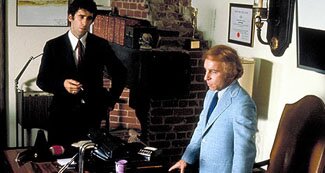
Marlowe “wakes up” because something has wakened him: the death of his friend Terry Lennox. He remains true to his friend, though for all intents and purposes it’s meaningless, isn’t it? (Terry is dead, after all.) Yet Marlowe won’t believe the murder and suicide that are being attributed to his friend.
No one else in the movie is true to anyone or anything. Even Marlowe’s cat abandons him when its favourite food is no longer there. Marty Augustine (Mark Rydell) speaks of how much he loves his girlfriend then strike her horribly for no reason. Roger Wade hits his wife when he is drunk.
Throughout the movie, as Marlowe makes his way, he sees a world of self-interest and no loyalty, making him an anachronism. When asked why he would try to clear the name of Terry Lennox, he hears variations of, “What’s it matter? He’s dead.”
The ending aside, this is probably the greatest deviation from the novel. In the book, respect and loyalty keep appearing – Marlowe is hired for his; the gangsters in the book (unlike the Marty Augustine character) respect Marlowe for his loyalty. Even some of the cops do. He is sought out and hired because it’s reported in the newspapers that he was picked up by the police for questioning and wouldn’t talk.
So the difference in the endings becomes a bit curious. Is it simply a more overt, can’t-miss-that meaning concerning betrayal of a friendship or is it also suggesting that Marlowe, too, is becoming part of that amoral culture of self-centeredness?
I’m not really sure. But I do know this is a curious movie Robert Altman has given us.

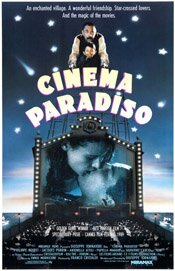 Cinema Paradiso (1988)
Cinema Paradiso (1988)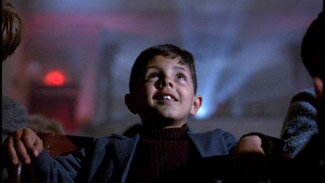 But once the credits are over and we’re at the furthest distance of the pull back, we see we’re in a room in a house. Dialogue begins and we see Salvatore’s mother move into the frame. The serene beauty of the opening shot, the staged nostalgic memory (which is what the opening has been) is disrupted by reality of everyday life.
But once the credits are over and we’re at the furthest distance of the pull back, we see we’re in a room in a house. Dialogue begins and we see Salvatore’s mother move into the frame. The serene beauty of the opening shot, the staged nostalgic memory (which is what the opening has been) is disrupted by reality of everyday life.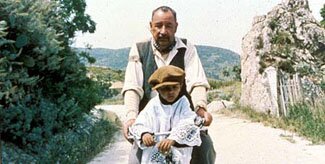 Alfredo, the projectionist at the town of Giancaldo’s movie theatre, the Cinema Paradiso, and who is the key figure in Salvatore’s life, is seemingly imprisoned. With the exception of a few scenes, we almost always see him looking through his window on the square, looking through the small opening in the projection room on the theatre, or loading and unloading reels of film in his cramped projection room. His life is contained by these small confines. He is always an observer. He is never a part of the audience below him in the theatre who seem to be continually chattering and interacting.
Alfredo, the projectionist at the town of Giancaldo’s movie theatre, the Cinema Paradiso, and who is the key figure in Salvatore’s life, is seemingly imprisoned. With the exception of a few scenes, we almost always see him looking through his window on the square, looking through the small opening in the projection room on the theatre, or loading and unloading reels of film in his cramped projection room. His life is contained by these small confines. He is always an observer. He is never a part of the audience below him in the theatre who seem to be continually chattering and interacting.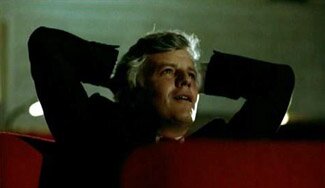 Alfredo, knowing this, and sensing the cinematic artist in Salvatore, undermines the relationship between Salvatore and Elena. This action parallels that of the town’s priest who in the first part of the film had been ordering the censoring of all the scenes involving kisses, scenes that suggested intimacy.
Alfredo, knowing this, and sensing the cinematic artist in Salvatore, undermines the relationship between Salvatore and Elena. This action parallels that of the town’s priest who in the first part of the film had been ordering the censoring of all the scenes involving kisses, scenes that suggested intimacy.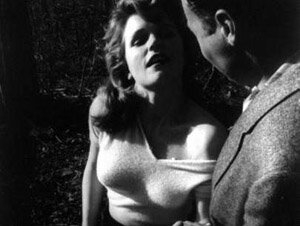 What I like about Anatomy of a Murder is that every so often a friend will say something like, “… This movie I saw on TV was so good …” As they describe it I realize what movie they mean and remark, “That’s Anatomy of a Murder.”
What I like about Anatomy of a Murder is that every so often a friend will say something like, “… This movie I saw on TV was so good …” As they describe it I realize what movie they mean and remark, “That’s Anatomy of a Murder.”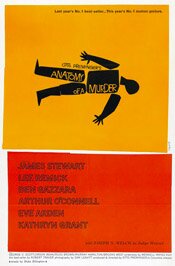 Anatomy of a Murder (1959)
Anatomy of a Murder (1959)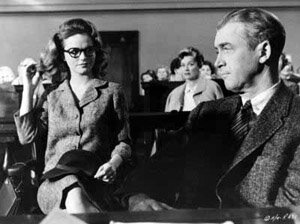
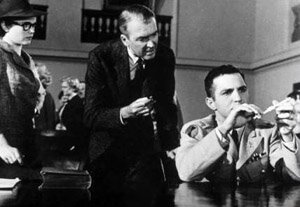
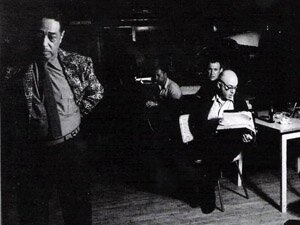
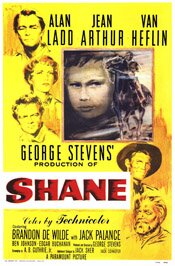 Shane (1953)
Shane (1953)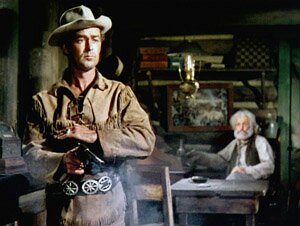 Unfortunately for someone from my generation, the story of Shane is one we’re too familiar with from it’s recapitulations, especially the Clint Eastwood films like High Plains Drifter and Pale Rider. Alan Ladd as Shane, despite director George Stevens’ efforts, is a little too clean, a little too smooth shaven. He’s not harsh enough. I’m not sure this is a flaw with the film so much as it’s a flaw with seeing it from a distance in time.
Unfortunately for someone from my generation, the story of Shane is one we’re too familiar with from it’s recapitulations, especially the Clint Eastwood films like High Plains Drifter and Pale Rider. Alan Ladd as Shane, despite director George Stevens’ efforts, is a little too clean, a little too smooth shaven. He’s not harsh enough. I’m not sure this is a flaw with the film so much as it’s a flaw with seeing it from a distance in time.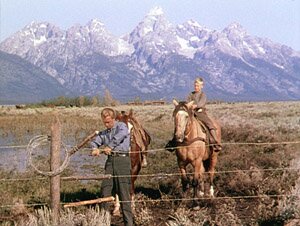 Of course, there is a helluva lot more to it than that. But that’s the basic premise. It’s the western model Eastwood used many times. The film is self-consciously rooted in a myth and wants to comment on it. It especially wants to comment on violence.
Of course, there is a helluva lot more to it than that. But that’s the basic premise. It’s the western model Eastwood used many times. The film is self-consciously rooted in a myth and wants to comment on it. It especially wants to comment on violence.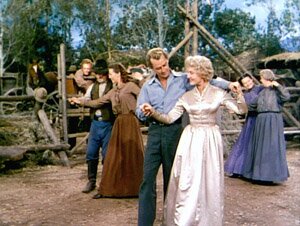 Meanwhile, we are constantly aware that eventually Shane must draw his gun and the big showdown must come. But it takes forever. There are legitimate reasons for why it takes so long, and you can appreciate what George Stevens is trying to do, but … it takes so damn long! And the film is so restrained.
Meanwhile, we are constantly aware that eventually Shane must draw his gun and the big showdown must come. But it takes forever. There are legitimate reasons for why it takes so long, and you can appreciate what George Stevens is trying to do, but … it takes so damn long! And the film is so restrained.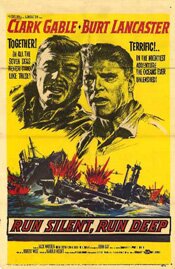 Run Silent, Run Deep (1958)
Run Silent, Run Deep (1958)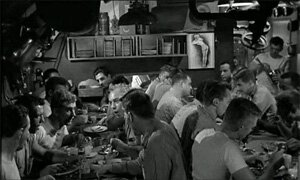 Run Silent, Run Deep is a guy movie. There are really only two female roles in the movie: a very small part as Gable’s wife (Mary LaRoche) and a pin-up poster. It’s all guys and for the most part they are confined in a submarine. Despite that, it’s a good movie. Actually, it is because of that it is a good movie. It knows what it is about and its focus doesn’t waver.
Run Silent, Run Deep is a guy movie. There are really only two female roles in the movie: a very small part as Gable’s wife (Mary LaRoche) and a pin-up poster. It’s all guys and for the most part they are confined in a submarine. Despite that, it’s a good movie. Actually, it is because of that it is a good movie. It knows what it is about and its focus doesn’t waver.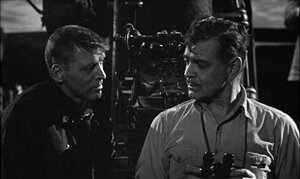 Gravitas, like the word gravity, comes from the Latin word “gravis” which means seriousness or weightiness. Gable communicates it wonderfully. Lancaster does to a degree too, though in a different way. Between the two actors, you get a nicely dramatic contrast.
Gravitas, like the word gravity, comes from the Latin word “gravis” which means seriousness or weightiness. Gable communicates it wonderfully. Lancaster does to a degree too, though in a different way. Between the two actors, you get a nicely dramatic contrast.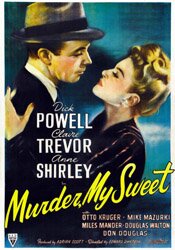 Murder, My Sweet (1944)
Murder, My Sweet (1944)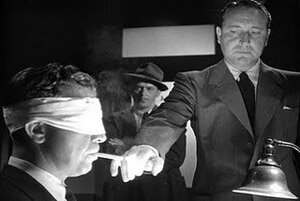 For many people Humphrey Bogart (The Big Sleep) is the Philip Marlowe. But just today I came across a review where the writer was claiming the best Marlowe was Robert Mitchum in 1975’s Farewell, My Lovely.
For many people Humphrey Bogart (The Big Sleep) is the Philip Marlowe. But just today I came across a review where the writer was claiming the best Marlowe was Robert Mitchum in 1975’s Farewell, My Lovely.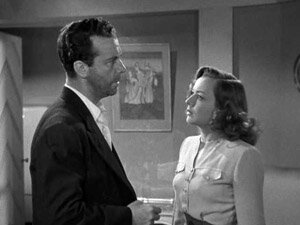 In other words, the movie twists quite a bit and in many cases the twists are arbitrary for the sake of being a twist and to sustain the mood. But they don’t make a lot of sense. Yet in a film noir, you can often get away with that because the movie is less about plot and more about atmosphere, characters, character relationships … and lighting and camera focus.
In other words, the movie twists quite a bit and in many cases the twists are arbitrary for the sake of being a twist and to sustain the mood. But they don’t make a lot of sense. Yet in a film noir, you can often get away with that because the movie is less about plot and more about atmosphere, characters, character relationships … and lighting and camera focus.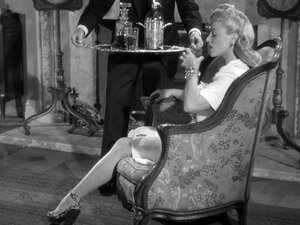 Being film noir, we also get a femme fatale. Claire Trevor is Mrs. Helen Grayle, aka Velma. Director Edward Dmytryk introduces her to us legs first, underlining the character’s sexual nature and involvement with the story. But the there is also Anne Shirley as Ann Grayle, step-daughter and enemy of the second Mrs. Grayle (Velma). It’s easy to see why.
Being film noir, we also get a femme fatale. Claire Trevor is Mrs. Helen Grayle, aka Velma. Director Edward Dmytryk introduces her to us legs first, underlining the character’s sexual nature and involvement with the story. But the there is also Anne Shirley as Ann Grayle, step-daughter and enemy of the second Mrs. Grayle (Velma). It’s easy to see why.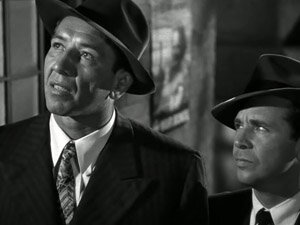 But the movie isn’t just about this. It begins with a man named Moose (Mike Mazurki), who is just out of jail and looking for his Velma.
But the movie isn’t just about this. It begins with a man named Moose (Mike Mazurki), who is just out of jail and looking for his Velma.